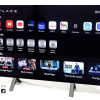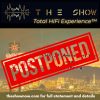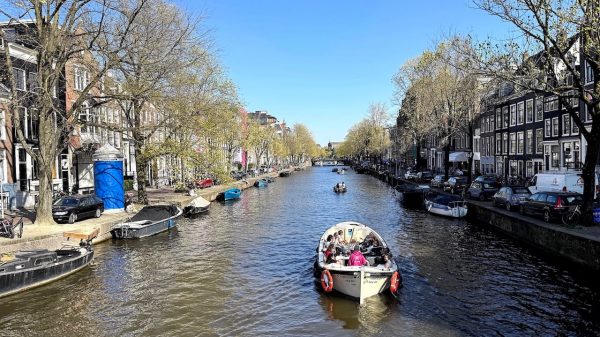When I travel to Japan, two destinations are givens. First, Sapporo as that’s where my wife is from and where I lived for four years in the distant past, so I have family and friends to visit. Second, Tokyo because… it’s Tokyo. For variety, I always add a third destination; last year it was Nagoya and the trip before, prior to the pandemic, it was Fukuoka. And for each destination, Jazz Kissa sessions are a must.

When planning the third destination for my current trip, I first thought I’d like to go to the Sendai area and maybe throw in a night in Yamagata. I lived in both cities for a year each back in the ‘90s, long before my Kissa obsession took hold, and thought it would be fun to combine a revisit with some jazz and coffee.
Further pondering led me to the conclusion it was silly to go to Sendai from Tokyo, return to Tokyo, and then head up to Sapporo; Tohoku (the north part of the main Japanese island of Honshu) is a treasure trove of Jazz Kissas, and it made more sense to travel through the area and on to Sapporo, visiting Kissa along the way. The plan started to take shape.

A 7-day Japan Rail Pass is ¥50,000, but there is a 6-day regional pass good for Tokyo, Tohoku and southern Hokkaido (the JR East-South Hokkaido Rail Pass) that costs only ¥35,000. That’s a significant cost-saving, so a 6-day trip, travelling to the Sapporo on the last day, was set. Now to fill in the rest of the itinerary.

Pro tip: If planning a trip to a specific area of Japan only, check out the regional rail passes!
Researching Tohoku Kissas, I found dozens and dozens of candidates for visits. Many are in tiny communities, far off the beaten path. Since this was to be a dash up the island, those were eliminated from consideration (for this trip); I decided to focus on Kissas in towns and cities with shinkansen (bullet train) access and spaced out for shortish hops between stops.
An initial plan took shape. Day 1: Tokyo to Fukushima (visit Mingus, stay overnight); Day 2: Fukushima to Yamagata (visit Octet and Jazz Kohi En, stay); Day 3: Yamagata to Sendai (visit Count, stay); Day 4: Sendai to Ichinoseki (visit Basie) to Morioka (visit Dante, stay); Day 5: Morioka to Hakodate (visit Leaf and J.B. House, stay); Day 6: Hakodate to Sapporo

A few weeks later while messaging with my friend Miles in Sydney, Australia, I mentioned the Kissa adventure. Soon after I got a follow-up message asking if he could join me as he’d become curious about Kissa culture as well. He’d combine the trip with some business in Singapore and Tokyo, flying in a few days early for some meetings and then tacking the Tohoku jaunt on after. A buddy trip seemed more fun than a solo trek, and dates were set to satisfy both our schedules.

Miles spent a year teaching English in Hirosaki in northern Tohoku in the late ‘90s so it only seemed fair to add a stop there so he could see his temporary home of 26 years ago; a day was thus added to the trip at the end between Morioka and Hakodate. We’d pay for tickets separately for the first leg of the trip and activate our 6-day rail passes in Fukushima.
Further research on the Kissas we’d be visiting revealed that Basie in Ichinoseki was temporarily closed. It didn’t say why, but it looked like Ichinoseki was off the itinerary, though it didn’t impact much other than making the Sendai to Morioka hop a bit simpler. Hotel rooms were soon reserved, and Thunderbirds were go!

Fast forward a month and we were on the shinkansen at Tokyo Station, ready for launch.
Fukushima
Fukushima is a small city about 90 minutes north of Tokyo by bullet train. It’s the capital of Fukushima Prefecture (home of the nuclear power plant knocked out by the 2011 tsunami), and pretty unremarkable. There are a couple of department stores and several hotels near the station, a small restaurant/entertainment district, and not much else besides apartments and houses.

For two foreigners on a music hunt for records and Kissas, Mingus was the one real target location. We did go to a record store (or a general entertainment store that had a small record corner) out on the edge of town, but it was rather disappointing. And by that I mean very disappointing.
Jazz Spot Mingus
We had a cracking time at Mingus. Arrived around 8:00 after a tasty Japanese dinner of mostly grilled meats and fish (this would be a common dinner choice in the coming days), and the place was empty. We asked the master, Matsuura-san, if it was always this quiet on a Sunday but he assured us some regulars would show later. They’d had a live concert event the night before, which he said was well attended, but the diehards would still make it in. Sure enough, they did (a group of about 12 arrived soon after and were still there chatting away – no “no-talking” rule here – when we left a couple of hours later).

Mingus is quite a large space with a band area for live performances and seating for easily 40 or more. It’s a bit too big in my mind for an ideal Jazz Kissa (I prefer something a bit cozier), but I can imagine it’s a superb venue for live jazz concerts with a good crowd. I’d have loved to be there the night before!

That said the sound in the space was excellent, bar the fact that some records were a bit crackly. Matsuura-san was friendly and brought over the cover of practically everything he played for our perusal, including several autographed covers and one record with a photo of him in younger days with Art Blakey. It’s pretty clear Mingus has seen its fair share of jazz stars pass through over the decades.

Yamagata
Yamagata is the capital of Yamagata Prefecture. It’s about 75 minutes by shinkansen from Fukushima, and quite a bit bigger and busier. There is a ski resort (Zao) nearby with an onsen (hot spring spa), in addition to a famous temple complex (Yamadera). Yamagata Castle near the station is also worth a visit, especially in the spring when the sakura (cherry trees) are in bloom.

This was my first time back in Yamagata since I left town in 1997. The basic layout hasn’t changed, though a lot of the buildings have (demolished and replaced), including the one I worked in for a year.
Unlike most Japanese urban centers with offices and retail located near the main train station, Yamagata’s core is a few blocks away from the station, probably built that way in the beginning to not interfere with existing infrastructure at the time. The fact this arrangement has continued might indicate that trains and travel out of town are not central to life in this area.

Record shopping here was more fruitful than in Fukushima. We found two spots that yielded treasures for both of us (jazz for me, and jazz and club music for Miles). Music Showa was a bit out of the way (a good 2 km walk from the downtown core) but was worth the trek. It has used records on the ground floor, new records and vintage audio equipment on the second, and spaces here and there with musical instruments and lesson rooms.

Biscuit records is closer to the core and station, and more club focused. I dug a bit in the small jazz and Japanese Jazz sections, then headed to Octet leaving Miles to dig the extensive club crates.
Jazz And Coffee Octet
Octet is a quintessential Jazz Kissa – cozy, dimly lit, lots of wood, shelves and shelves of records, and totally worth a visit. I loved that the shop sports the same amplifier combo (McIntosh C28 and MC2105) as I have at home. Speakers (hard to see) are big ole JBL 4333s (the 43XX JBLs are almost “standard issue” for Kissas of this size), and turntables are by Technics and Denon.

The master and patrons were friendly and talkative; had some nice chats with folks, though at low volumes (talking is okay here, but the focus is still the music). One customer I talked with was surprised I lived in Yamagata before, and very curious about gaijin (foreigners) loving jazz kissa, while the master was very interested to see the records I had bought earlier.

The table I sat at was covered with Jazz magazines and books, an indication that this is a place to relax and wile away time. Included in the piles was the 4-volume series of “Jazz Kissa” glossy magazines, with Octet featured on pgs. 118 and 119 of the Jazz Kissa 2014 Volume 1 edition.

We ended up spending most of the afternoon at Octet, with time both stopping and rushing by. A great experience, and one I’d happily do again.

Jazz Kohi En (JAZZコーヒー園)
Rather than head straight for a second Kissa after Octet, we decided to savor the experience and keep shop number two for the following morning.
We arrived at Jazz Kohi En (Kohi is Japanese for Coffee) shortly after its 11:00 opening time. I’ll admit I knew little about this shop other than that it existed (thank you Google Maps) and had pretty good reviews. Pleasantly surprised would be an understatement as everything about this Kissa blew me away.

Jazz Kohi En is perhaps the perfect Kissa space, but not one I’d ever imagined. Where my Kissa mental map was something like Octet the day before – old and rustic – the ambiance here is bright, sleek and understatedly Mid Century Modern. Styling is exceptional, and everything is exquisitely and lovingly clean and tidy.

The shop first opened in 1969 and has been in its current location for 45 years. The original master passed away in 2023, and his widow (I wish I’d gotten her name) now keeps the business going. She’s lovely and we had a nice chat about the shop and about our Tohoku tour.
One of her regular customers, reading the newspaper and sipping coffee at the counter over his work break, joined in. He was most surprised that I was able to take a month off work for my Japan trip (more than a week at a time in Japan is practically unheard of) and concerned about the cost of hotels for a trip that long (thankfully I had friends and family to stay with more than half of the trip, and Japanese hotels are way less expensive than those back home, especially during the week and outside tourist season).

Sonically Jazz Kohi En is – like the ambiance – brighter and cleaner than most of the other Kissas I’ve visited. Speakers are Siemens drivers in a massive open-baffle setup, emphasizing detail over bass, driven by a multitude of pre- and power amplifiers (the shop uses different amplifier combos for playing CDs and vinyl). The turntable was one of many Technics SL1000s seen on this trip, this one with the original factory plinth.

Miles and I agreed that we could easily have spent the whole day in this wonderful space. Jazz Kohi En slots in at No. 1 of the Tohoku trip’s Kissa experiences. Unfortunately, we had a train to catch, so after coffee, lunch, more coffee and dessert, off to the station we headed.

Onward
Our next stop would be Sendai, but for that and the continuation of our journey north you’ll have click through to Part 2 of the story…
Related Reading:












































Aharon White
October 23, 2024 at 9:58 pm
Japan is starting to look more and more intriguing to me. Love these stories Eric.
Pity I’m having stomach/hernia surgery in December and have to send Chris in my place to Japan for a Panasonic junket.
Eric Pye
October 24, 2024 at 6:46 pm
Big miss for you… but surely another Japan audio junket can be arranged 😉
Carlos
October 24, 2024 at 11:34 am
I really enjoyed this episode/piece/article and the photos are also great. Until instagram came along I’d never heard of a Kissa but they look really interesting. I need to find a book or two on the Kissa culture… can you recommend any?
Eric Pye
October 24, 2024 at 6:45 pm
Check out Tokyo Jazz Joints. I think it’s available on Amazon. Mostly pictorial, but a great volume. Also the Jazz Kissa magazines (look up @jazz_kissa on Instagram and follow the link in their profile) are wonderful too.